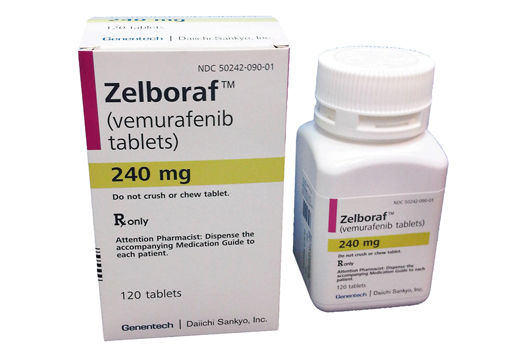
Two new drugs have been approved by the US Food and Drug Administration (FDA) for use in certain patients with metastatic or unresectable melanoma, along with a diagnostic test to identify patients who are suitable for treatment.
The new products, dabrafenib (Tafinalar) and trametinib (Mekinist), were both developed by GlaxoSmithKline. Both are orally available tablets, but they have slightly different mechanisms of action.
Dabrafenib acts as a BRAF inhibitor and is approved for use in patients with melanoma whose tumors express the BRAF V600E gene mutation. It is seen as being a next-generation product but is in the same class as the first BRAF inhibitor to reach the market, vemurafenib (Zelboraf, Genentech).
Trametinib has a related but slightly different mechanism and acts as a mitogen-activated, extracellular signal-regulated kinase inhibitor (MEK inhibitor). It is the first drug in this class to be approved and is indicated for use in patients with whose tumors express the BRAF V600E or V600K gene mutations.
Approximately half of melanomas arising in the skin have a BRAF gene mutation, the FDA notes in its approval notice. Alongside the new drugs, the agency also approved a genetic test, the THxID BRAF test, a companion diagnostic developed in collaboration with bioMérieux that will help determine wither a patient's melanoma cells have the V600E or V600K mutation in the BRAF gene.
Melanoma is the leading cause of death from skin disease, the FDA adds. The National Cancer Institute estimates 76,690 Americans will be diagnosed with melanoma and 9480 will die from the disease in 2013.
Clinical Trial Data
Dabrafenib was approved on the basis of data from the BREAK 3 study, conducted in 250 patients with previously untreated BRAF V600 mutation–positive metastatic melanoma. It showed that in such patients, dabrafenib significantly improved the median progression-free survival compared with chemotherapy with dacarbazine (5.1 vs 2.7 months; P < .0001). These results were published in July 2012 issue of the Lancet (2012;380:358-365).
The FDA notes that the most serious adverse effects reported in patients receiving dabrafenib included an increased risk for cutaneous squamous cell carcinoma, fevers that may be complicated by hypotension, severe rigors, dehydration, kidney failure, and increased blood sugar levels requiring changes in diabetes medication or the need to start medicines to control diabetes.
The most common adverse effects reported in patients receiving dabrafenib included hyperkeratosis, headache, fever, joint pain, noncancerous skin tumors, hair loss, and hand–foot syndrome.
The pivotal study for trametinib, the METRIC study, was a little different in that it was conducted in 322 patients who had already tried a prior regimen of chemotherapy. In this study, compared with chemotherapy, trametinib significantly improved progression-free survival as well as overall survival. The results were published in the New England Journal of Medicine.
The FDA notes that the most serious adverse effects reported in patients receiving trametinib included heart failure, lung inflammation, skin infections, and loss of vision. Common adverse effects included rash, diarrhea, tissue swelling (peripheral edema), and skin breakouts that resemble acne.
The agency also noted that women of childbearing years should be advised that dabrafenib and trametinib carry the potential to cause fetal harm. Men and women should also be advised that both drugs also carry the potential to cause infertility.
Being Investigated in Combination
Dabrafenib and trametinib have been approved for use as monotherapy, and not as a combination treatment, the FDA has emphasized. However, there is a lot of interest from clinicians in using both drugs together, and indeed the manufacturer is conducting a clinical trial with the combination.
Preliminary results from a clinical trial with the combination suggest that use of the 2 drugs together resulted in less toxicity, and specifically in fewer secondary skin cancers, than has been seen withvemurafenib used alone.
GlaxoSmithKline is now conducting a phase 3 study (known as COMBI-AD) of the combination of dabrafenib and trametinib in patients with BRAF V600 melanoma that has been completely removed by surgery. Such patients are at high risk for relapse, and the combination of drugs is being tested to see whether it can delay or prevent the recurrence of melanoma, the company noted.
Problem: Responses Are Short-lived
The new dabrafenib appears to be similar to the already-marketed vemurafenib, but there are important differences between the 2 BRAF inhibitors in their toxicity profiles, noted Kim Margolin, MD, from the Seattle Cancer Care Alliance in Washington, commenting in a recent Medscape videoblog.
Skin toxicities, particularly the emergence of low-grade squamous cancers and keratoacanthomas, which occurred in a substantial number of patients taking vemurafenib, appear to be quite unusual with dabrafenib, Dr. Margolin noted. However, a systemic "pyrexia reaction," which is almost never seen with vemurafenib, has been seen in a substantial percentage of patients taking dabrafenib. "We don't know yet about the off-target mechanisms of these differences and how much may be due to the vehicle or the formulation for each of these oral agents," she added.
However, the biggest problem with the BRAF inhibitors in the treatment of melanoma has been the lack of durable response: These drugs "tend to work for an average of 5 to 6 months," Dr. Margolin noted. What to do when patients fail on these drugs remains a challenge, she added.
Ultimately, combination therapy with a BRAF inhibitor (such as vemurafenib or dabrafenib) plus a MEK inhibitor (such as trametinib) is "likely to be most valuable for improved and lasting results," according to Dr. Margolin, commenting on dabrafenib last year.





 留言列表
留言列表
 線上藥物查詢
線上藥物查詢 